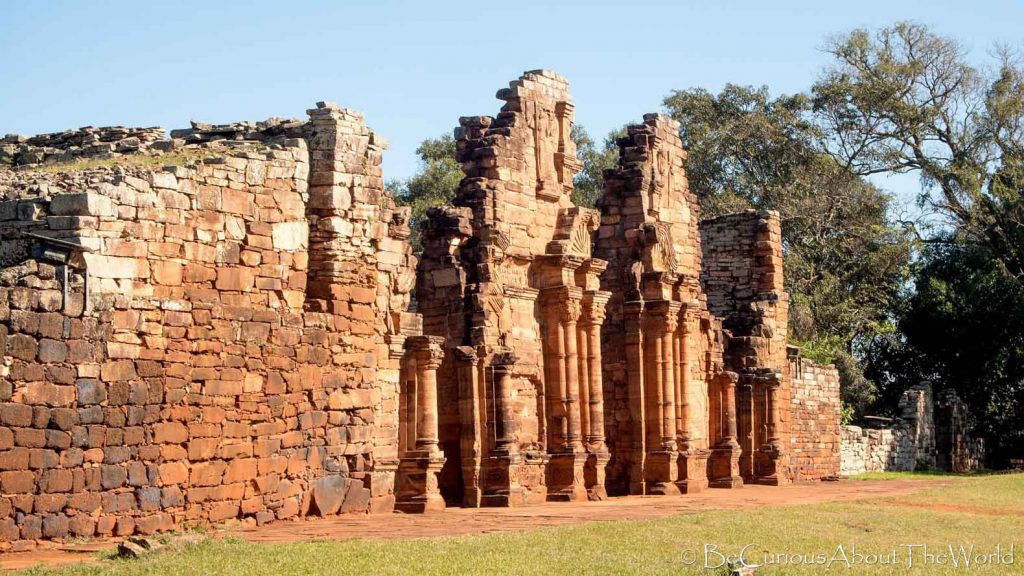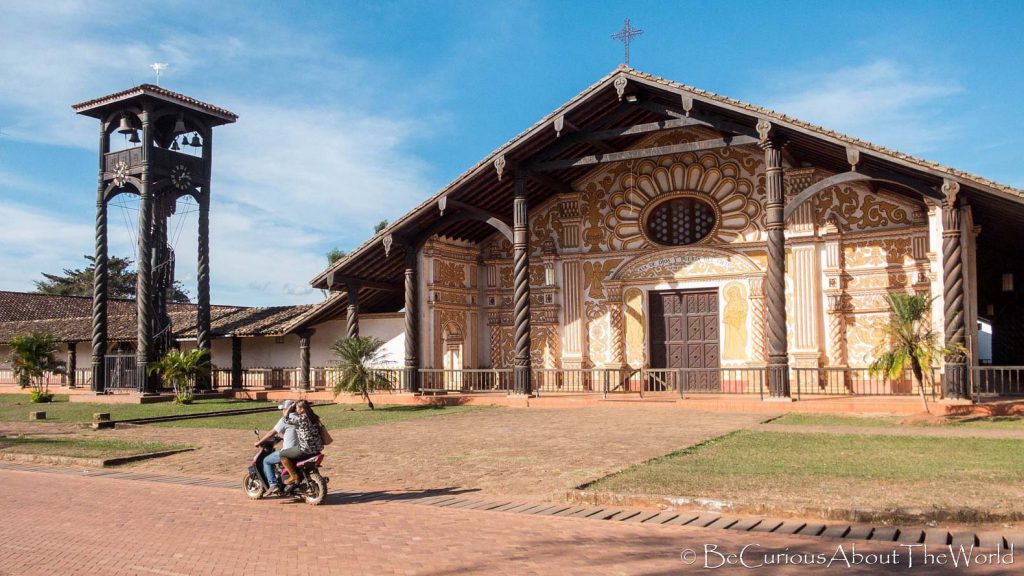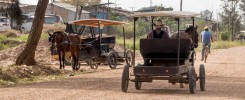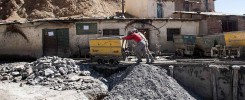I’m wandering on the ruins of the church, jumping from stone to stone, from beam to beam – as in the Prince of Persia computer game, but a little less neatly. Looking into crypts with turned coffins and observing how invasive philodendrons and fig trees burst stone structures out. Looking for nice photo frames … Then I am told that the venomous jararaca often heats up on this rubble. Oops …
Ruins of Jesuit missions without even a basic knowledge of their difficult and variously evaluated history would remain a pile of stones covered with fig trees. Maybe at times a charming and photogenic pile but only just a pile. Listen then …
A bit of history
In the seventeenth century together with brandishing swords conquistadors, the missionaries brandishing their crosses came to America from the ‘old world’. Many of them flourished so vigorously that more than one Indian got hit in the head, and more than one clod of precious metal sticked to a greedy monk’s hand. Many also rolled up cassocks in the chase of indigenous women, denying any ideas and values they propagated. Christianization was going at full blast, and the frigates overloaded with church gold took courses towards Seville catching Eastern trade-winds. The intentions of Europeans were quite vividly described by the King of Spain Ferdinand of Aragon, who reportedly stated that “if the Indians do not surrender themselves voluntarily, they will be exterminated.” Wow, how charming and egalitarian it was… But this is only one side of the coin.

Society of Jesus
It seems today that at least some of the missionaries from the Society of Jesus showed a little more dignity, and in fact they were a little bit concerned with the promotion of Christianity, culture and education. It went easy with the friendly Guarani Indians, because their faith in one main god and his children corresponded fairly well with the proposal of the Catholic church. It was only necessary to exterminate polygamy and rare cases of cannibalism – piece of cake. In addition, the missionaries learned the language of Guarani and worked on its development by introducing the first books and printing. Knowledge of the local language let set up sympathetic and facilitated communication, and so the missionary administration functioned quite well on the basis of close cooperation with local caciques.
Missionary success
More and more missions/reductions were continually set up in the jungle. They became extraordinary communist cities. Surrounded by the missionary organization, the Indians lived reasonably comfortably and safely, while outside there was a difficult and harsh life in the jungle. While cruel roundups of slaves took place outside, behind the walls of the missions missionary schools flourished, and remarkable Indian flair for art was developed. The missions grew to such an extent that numbers of their inhabitants exceeded the populations of large cities that time! Of course, nothing was for free and there were also consequences of it. Christianized Indians were gradually losing their tribal culture and separateness, and had to significantly reduce their freedom by subordinating themselves to monks. To dissatisfaction of certain classes, it only strengthened missionary independence. Reductions even obtained the right to own a weapon that effectively restrained the plundering invasions of the Portuguese. It seems, therefore, that missions became an institution brought by conquistadors which somehow defended the Indians against conquistadors. Strange? Perhaps, but even Guaranies do not deny this point of view today.
The end of the Jesuits’ activity
Everything ends up one day and the missionary success finally started to be an eyesore to the Spanish crown: a self-proclaimed, out of control missionary state and captured Indian souls, which the merciful king needed just as much as the church. And those greedy Portuguese in the neighbourhood. By virtue of the treaty signed in 1750 between Spain and Portugal, border areas in the colonies were exchanged. Part of the reduction went under the Portuguese reign, which was tantamount to their liquidation. Missionaries remained torn between loyalty to their Indians and loyalty to church leaders. In the end, the Society of Jesus was expelled from the territories of the Spanish crown, which, as it later turned out, determined the fate of the other missions. Soon after, there was a dissolution (liquidation) of the order. It was only after some time that another Jesuits’ order supersessioned them, and today continues the old good traditions. However, we do not judge it here.
The missions did not turn out to be self-sufficient enterprises and without the leading of Jesuits began to irreparably fall into ruin. Partly because of lack of spiritual and administrative leadership, and partly because of lack of Guaranies’ motivation who got used to the easy prosperity. Portuguese invasions and national liberation movements completed the rest. Debris has been left. The end of the events of those times is illustrated by the film entitled “Mission” with Robert De Niro and Jeremy Irons in the main roles. It was a valuable inspiration for us to visit this region.
It can not be concealed that, apart from the balanced views on this activity, there are still those for whom the missions were signs of God’s work and paradise on earth, and others for whom they were only indications of destructive communism and monk falsehood. No matter where the truth is, it cant’t be denied that it was the only such phenomenon on a global scale and a quite successful social-humanitarian experiment as well. Ehhh, if today’s hierarchs had equally bright ideas and that far reaching, wise look would replace these greedy, crafty eyes …
On the ruins of the missions
Today, the ruins of the mission are scattered at the junction of three borders: Brazilian, Argentinean and Paraguayan, and most of them have obtained the patronage of UNESCO. Only a dozen or so were left, because on the remaining ruins new villages were built. In many cases, not only the name but also the urban layout has been preserved, which means that, for example, the police station is like a former Jesuit library, and where there was a building for single women and orphans, the fire brigade functions today.
So this pile of stones is much more than just a pile – you just have to strain your imagination. We let ourselves be carried away by romantic visions from the past and, using the kindness of the custodians, we even slept behind the walls of some of the missions. The jungle was singing. At morning proud descendants of Guaranies were selling souvenirs and pizza smell was present nearby. The times are changing.

What has remained?
Finally, it is worth mentioning the fact that the missions in eastern Bolivia, which, unlike those in Paraguay or Argentina, have survived. Some of them have been meticulously restored and constitute magnificent monuments of Baroque architecture and art. Churches with long aisles, where decorated ceilings are supported on massive wooden columns. Around, the bright green jungle vegetation exists, and the exterior frescoes reminiscent of Romanian monasteries. Even nowadays, missionary music is cultivated here, and for many local Indians Bach is quite well known.
The remaining part of the missionary buildings is also interesting because a complete urban layout has been preserved, and the local population still lives and works in the buildings. In one gate is a restaurant, and a shop or a bank in another. The whole creates a charming, sleepy, small-town atmosphere.


